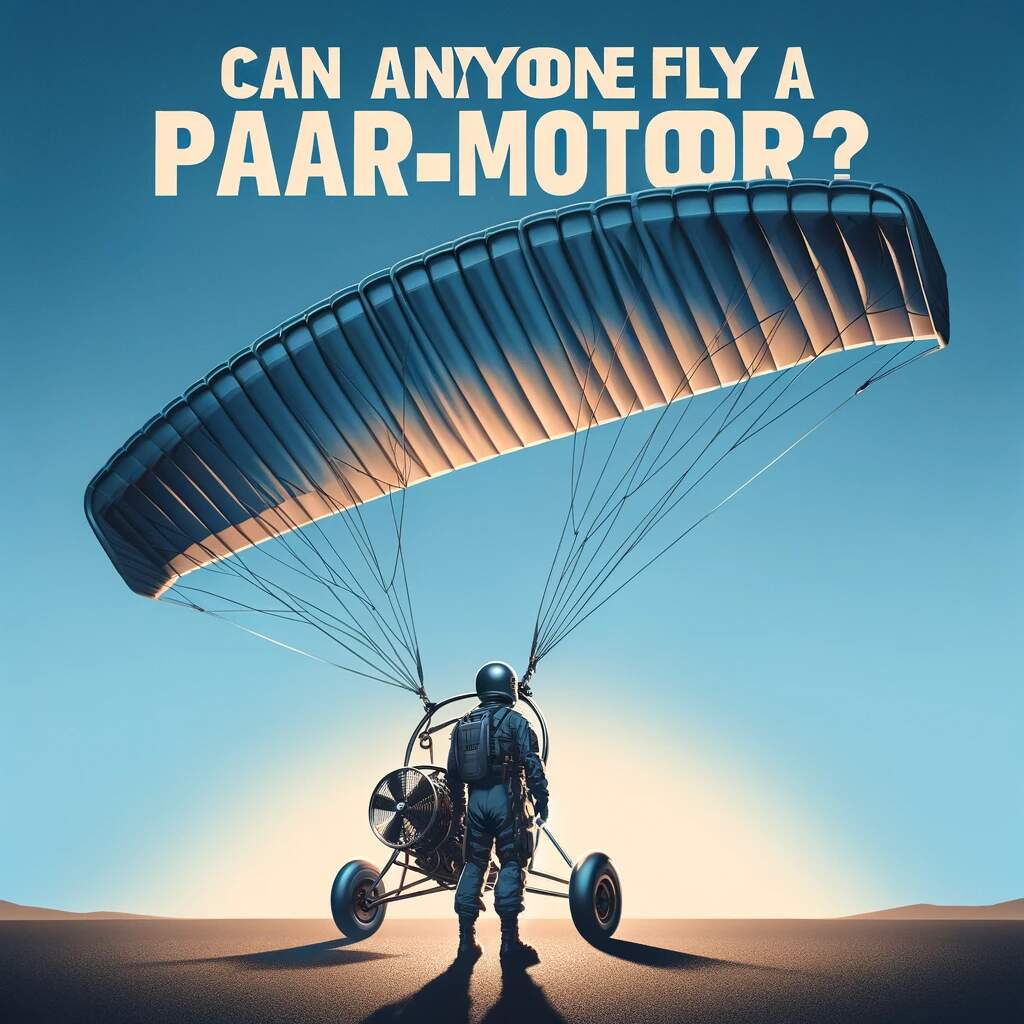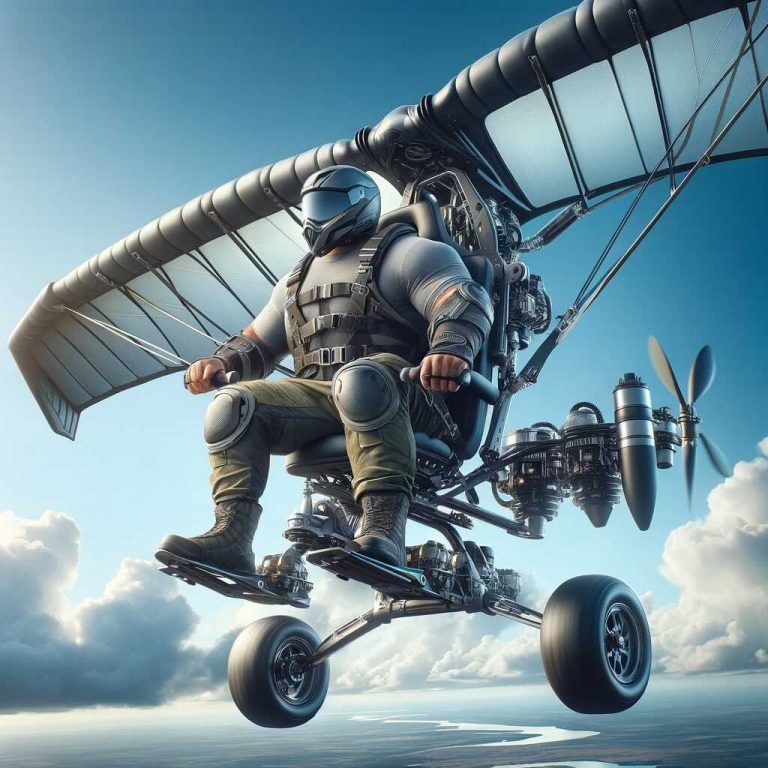Paramotoring, often referred to as powered paragliding, is a thrilling and accessible form of personal aviation that allows individuals to take to the skies with minimal training and equipment. It combines the simplicity of paragliding with the power of a small motor, providing a unique and exhilarating flying experience. But can anyone fly a paramotor?
Paramotors fall under the regulatory framework of FAR 103, which implies that there is no obligation for a license, medical certificate, training, or registration. Nevertheless, it is universally acknowledged that undergoing thorough training is absolutely essential for both the safe and enjoyable pursuit of this sport.
In this comprehensive guide, we’ll explore the world of paramotoring, from the requirements and training to the physical and mental aspects of flying a paramotor. Whether you’re a seasoned pilot or someone with no prior aviation experience, you’ll find valuable insights here.
The Basics of Paramotoring
Before we delve into who can learn to fly a paramotor, let’s start with the basics of this exciting sport.
What Is a Paramotor?
A paramotor consists of three main components: a paraglider wing, a paramotor engine, and a harness. The paraglider wing is a flexible, inflatable wing made of high-tech materials that provide lift and control. The paramotor engine, usually a small two-stroke gasoline engine, is attached to the pilot’s back and provides the necessary thrust for takeoff, level flight, and landing. The harness connects the pilot to the wing and engine, allowing for control and stability during flight.
A paramotoring is a foot-launched form of aviation, meaning that pilots take off and land on their feet. This eliminates the need for a runway, making it one of the most accessible forms of personal aviation available.
Why Choose Paramotoring?
Paramotoring offers a unique and thrilling experience that appeals to a wide range of people. Here are some of the reasons why individuals choose to take up paramotoring:
- Accessibility: Paramotoring requires minimal infrastructure. You can take off from almost any open field, making it accessible to people in rural and remote areas.
- Affordability: Compared to traditional aircraft, paramotoring is relatively affordable. The cost of equipment and training is significantly lower, making it an attractive option for those on a budget.
- Freedom: Paramotor pilots have the freedom to explore the skies at low altitudes, enjoying breathtaking views and a sense of adventure.
- Minimal Training: While proper training is essential for safety, paramotoring requires less training compared to many other forms of aviation.
- Community: There is a vibrant paramotoring community worldwide, with enthusiasts and experienced pilots eager to share their passion and knowledge.
Now that we understand the basics of paramotoring, let’s explore who can learn to fly a paramotor.
Who Can Learn to Fly a Paramotor?
Paramotoring is known for its accessibility, but it’s essential to understand the requirements and considerations for aspiring pilots. Let’s break down who can learn to fly a paramotor:
Age Requirements
Paramotoring is open to a broad range of age groups, but there are some age-related considerations:
- Minimum Age: In many countries, the minimum age to fly a paramotor is typically around 16 to 18 years old. However, the exact age requirement can vary by location, so it’s essential to check with your local aviation authority.
- Physical Fitness: While there is no strict upper age limit for paramotoring, it does require a reasonable level of physical fitness. Pilots should be capable of running with the motor on their backs during takeoff and maintaining control during flight.
Physical Fitness
Paramotoring is a physically demanding activity, and prospective pilots should be aware of the following physical requirements:
- Strength: Pilots must have sufficient upper body strength to handle the paramotor’s weight and control the wing during takeoff, landing, and flight.
- Endurance: Flying a paramotor can be physically demanding, especially during longer flights. Pilots should have good cardiovascular endurance to manage the physical exertion.
- Mobility: Flexibility and mobility are crucial, as pilots need to move their body to control the wing’s direction and pitch.
- Health: Pilots should be in good overall health, and it’s advisable to consult with a physician before taking up paramotoring, especially if you have any pre-existing medical conditions.
Mental Readiness
Flying any aircraft, including a paramotor, requires a certain level of mental readiness. Here are some mental aspects to consider:
- Calm Under Pressure: Paramotor pilots must remain calm and composed, especially during unexpected situations or turbulence. The ability to make quick, rational decisions is crucial for safety.
- Concentration: Flying a paramotor demands concentration and focus. Pilots need to monitor their altitude, weather conditions, and the state of their equipment at all times.
- Responsibility: Safety is paramount in paramotoring. Pilots must take full responsibility for their actions and decisions while flying, including weather-related choices and equipment maintenance.
- Training: A strong commitment to training and continuous learning is essential. Paramotor pilots should be open to acquiring new skills and improving their knowledge of the sport.
Training and Certification
While paramotoring is more accessible than many other forms of aviation, proper training is crucial for safety. Most countries require paramotor pilots to undergo formal training and obtain certification. Here’s what you can expect from paramotor training:
- Ground School: Paramotor training typically begins with ground school, where aspiring pilots learn about aerodynamics, weather, equipment, and safety procedures.
- Hands-On Training: Practical training includes kiting the wing (manipulating it on the ground), ground handling, and tandem flights with an instructor.
- Solo Flight Training: Once the instructor determines that you have the necessary skills and knowledge, you’ll progress to solo flight training. This involves taking off, flying, and landing on your own.
- Certification: Upon completing your training, you’ll typically earn a paramotor pilot certification, which may vary depending on your country’s regulations.
- Continued Learning: Paramotoring is a continuous learning experience. Experienced pilots often take advanced courses to improve their skills and knowledge.
Legal Requirements
In addition to training and certification, aspiring paramotor pilots should be aware of legal requirements in their area. These may include:
- Licensing: Some countries require paramotor pilots to obtain a specific pilot’s license, while others only mandate training and certification.
- Registration: Depending on your location, you may need to register your paramotor as an aircraft.
- Airspace Regulations: Understanding local airspace regulations and restrictions is essential for safe flying.
- Insurance: It’s advisable to have liability insurance in case of accidents or damage to property.
Gender and Paramotoring
Paramotoring is a sport that is open to individuals of all genders. There are no gender-specific restrictions, and both men and women can excel in this activity. In recent years, there has been a growing number of female paramotor pilots, breaking down traditional gender stereotypes in aviation.
Overcoming Barriers to Entry
While paramotoring is accessible to a broad range of individuals, there can be barriers to entry that need to be overcome. Here are some common challenges and how to address them:
Financial Constraints
Paramotoring can be cost-prohibitive for some individuals, especially when factoring in the cost of equipment, training, and ongoing expenses. To address this challenge:
- Budgeting: Plan your paramotoring journey carefully, considering all costs involved. Create a budget and save accordingly.
- Used Equipment: Consider purchasing used paramotoring equipment, but make sure it’s in good condition and meets safety standards.
- Training Grants and Scholarships: In some regions, there may be grants or scholarships available to help cover the cost of training.
Limited Physical Fitness
If you have concerns about your physical fitness, you can take steps to improve it:
- Exercise Routine: Start an exercise routine that focuses on strength and endurance training to prepare for the physical demands of paramotoring.
- Consult a Trainer: Consider working with a fitness trainer who can design a program tailored to your needs and goals.
- Medical Evaluation: If you have health concerns, consult with a physician to determine if there are any specific precautions or exercises you should undertake.
Fear of Flying
Fear of flying is a common barrier for some individuals. Overcoming this fear may involve:
- Mental Preparation: Seek support from mental health professionals or counselors who specialize in anxiety or phobias.
- Gradual Exposure: Start with tandem flights to gradually acclimate yourself to the experience of flying.
- Positive Visualization: Practice positive visualization techniques to reduce anxiety and build confidence.
- Supportive Community: Connect with experienced paramotor pilots who can share their experiences and offer guidance on overcoming fear.
Conclusion
In conclusion, paramotoring is an accessible and exhilarating form of personal aviation that can be enjoyed by a wide range of individuals. While there are age, physical, and mental considerations, with dedication and the right support, many people can learn to fly a paramotor. It’s essential to prioritize safety, undergo proper training, and be aware of legal requirements in your area.
Paramotoring offers the freedom to soar through the skies, providing breathtaking views and a unique sense of adventure. Whether you’re a young enthusiast, an older individual looking for a new hobby, or someone looking to overcome personal challenges, paramotoring may be the perfect fit for you. Remember, with determination and the right mindset, the sky’s the limit when it comes to paramotoring.
So, can anyone fly a paramotor? Yes, with the right training, mindset, and dedication, almost anyone can experience the thrill of paramotoring and enjoy the freedom of flight.








